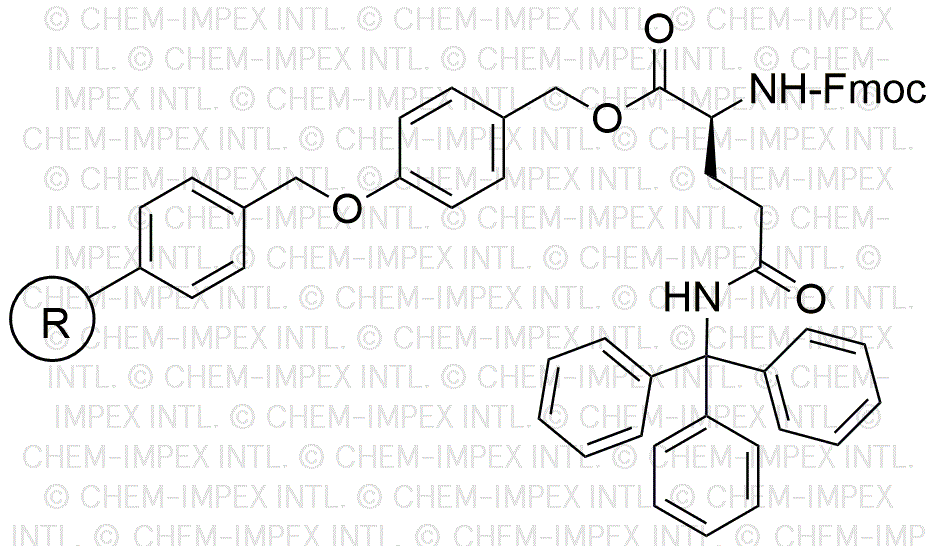Na-Fmoc- Nd-trityl-L-glutamine 4-alkoxybenzyl alcohol is widely utilized in research focused on:
- Peptide Synthesis: This compound serves as a protecting group in the synthesis of peptides, allowing chemists to selectively modify amino acids without affecting others. This is crucial in developing complex peptides for pharmaceuticals.
- Drug Development: Its unique structure aids in the design of novel drug candidates, particularly in targeting specific biological pathways. Researchers can leverage its properties to create more effective therapeutic agents.
- Bioconjugation: The compound can be used to link biomolecules, such as proteins and nucleic acids, to other functional groups. This is essential in creating targeted delivery systems for drugs or imaging agents in medical diagnostics.
- Research in Neuroscience: Its application in studying glutamate receptors can help in understanding neurological disorders, providing insights into potential treatments for conditions like Alzheimer's or Parkinson's disease.
- Custom Synthesis: Laboratories can utilize this compound for tailored synthesis of specific compounds, enhancing research capabilities and allowing for the exploration of new chemical entities.
General Information
Properties
Safety and Regulations
Applications
Na-Fmoc- Nd-trityl-L-glutamine 4-alkoxybenzyl alcohol is widely utilized in research focused on:
- Peptide Synthesis: This compound serves as a protecting group in the synthesis of peptides, allowing chemists to selectively modify amino acids without affecting others. This is crucial in developing complex peptides for pharmaceuticals.
- Drug Development: Its unique structure aids in the design of novel drug candidates, particularly in targeting specific biological pathways. Researchers can leverage its properties to create more effective therapeutic agents.
- Bioconjugation: The compound can be used to link biomolecules, such as proteins and nucleic acids, to other functional groups. This is essential in creating targeted delivery systems for drugs or imaging agents in medical diagnostics.
- Research in Neuroscience: Its application in studying glutamate receptors can help in understanding neurological disorders, providing insights into potential treatments for conditions like Alzheimer's or Parkinson's disease.
- Custom Synthesis: Laboratories can utilize this compound for tailored synthesis of specific compounds, enhancing research capabilities and allowing for the exploration of new chemical entities.
Documents
Safety Data Sheets (SDS)
The SDS provides comprehensive safety information on handling, storage, and disposal of the product.
Product Specification (PS)
The PS provides a comprehensive breakdown of the product’s properties, including chemical composition, physical state, purity, and storage requirements. It also details acceptable quality ranges and the product's intended applications.
Certificates of Analysis (COA)
Search for Certificates of Analysis (COA) by entering the products Lot Number. Lot and Batch Numbers can be found on a product’s label following the words ‘Lot’ or ‘Batch’.
*Catalog Number
*Lot Number
Certificates Of Origin (COO)
This COO confirms the country where the product was manufactured, and also details the materials and components used in it and whether it is derived from natural, synthetic, or other specific sources. This certificate may be required for customs, trade, and regulatory compliance.
*Catalog Number
*Lot Number
Safety Data Sheets (SDS)
The SDS provides comprehensive safety information on handling, storage, and disposal of the product.
DownloadProduct Specification (PS)
The PS provides a comprehensive breakdown of the product’s properties, including chemical composition, physical state, purity, and storage requirements. It also details acceptable quality ranges and the product's intended applications.
DownloadCertificates of Analysis (COA)
Search for Certificates of Analysis (COA) by entering the products Lot Number. Lot and Batch Numbers can be found on a product’s label following the words ‘Lot’ or ‘Batch’.
*Catalog Number
*Lot Number
Certificates Of Origin (COO)
This COO confirms the country where the product was manufactured, and also details the materials and components used in it and whether it is derived from natural, synthetic, or other specific sources. This certificate may be required for customs, trade, and regulatory compliance.


